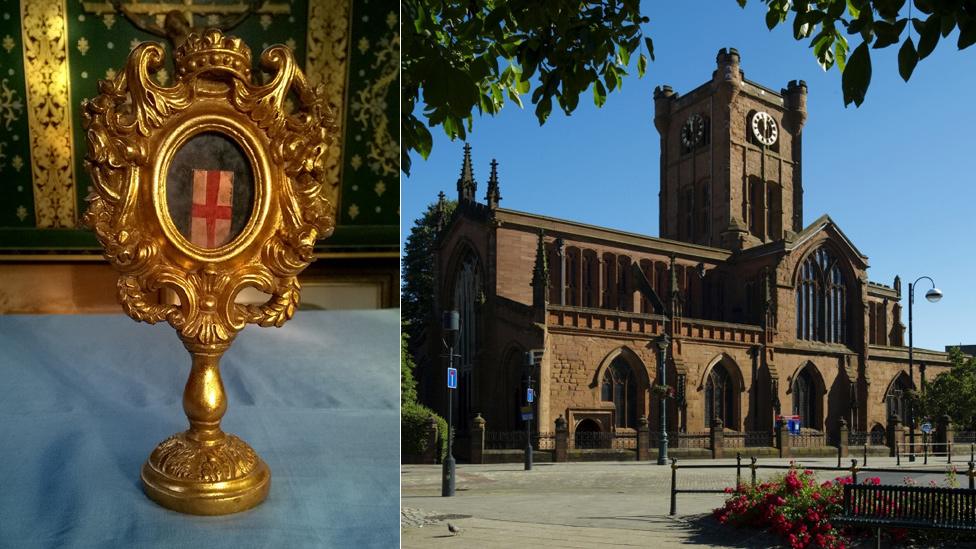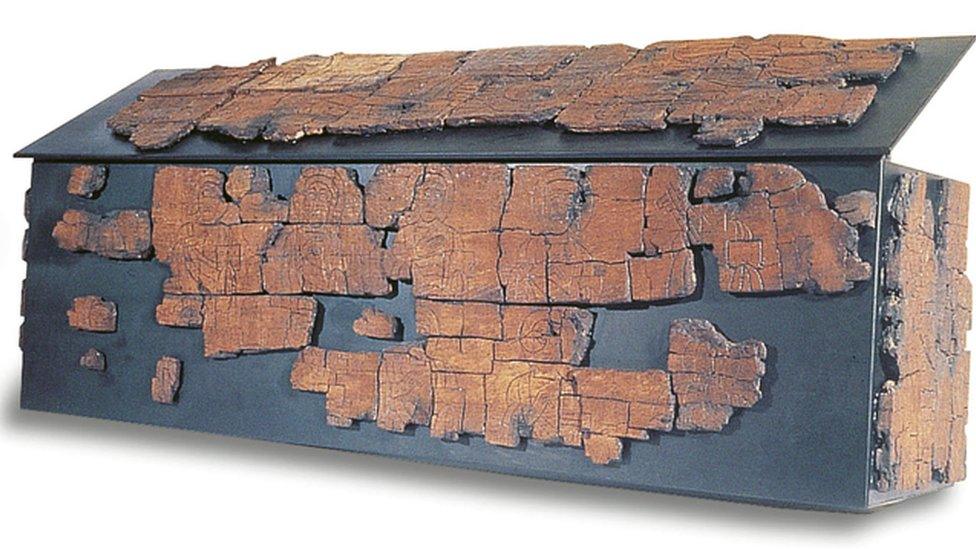St Valentine's finger beckons lovers to Coventry
- Published

A shard of bone believed to be from St Valentine's finger will be displayed in a reliquary placed on the altar at St John's church in Coventry
As romance beckons for lovers on Valentine's Day, there is the rare chance to see part of the saint "himself". A relic - purported to be a fragment of bone from St Valentine's finger - is on display at a church in Coventry. But what is it doing there?
Those hoping for a macabre thrill will be disappointed. This is no shrivelled finger on a cushion. The shard of bone is sealed inside a reliquary, an ornate case about 4 in (10 cm) tall.
But church warden Ann Tuesley hopes people will flock to a special Sunday Mass, which she described as "perfect for couples who are getting engaged".
There is no concrete reason St Valentine's finger should be in Coventry, although as church council member Cam Morgan said: "Coventry is a city of peace and reconciliation and it seems right that someone who valued courtly love is associated with our city".

There were three St Valentines associated with 14 February there are 11 St Valentines in total
In the early 1800s a catacomb in Rome purported to contain St Valentine was excavated.
According to theologian Kenneth L. Woodward, popes have tended to be generous with the remains of saints, which were treated as a "spiritual treasury". Many important visitors to Rome came away with the gift of a saint's body - or at least part of one.
Relics became symbols of prestige for churches and cities, and St John's Church was a well-established and influential place of worship. It was founded in 1344 following the death of Edward II by his widow Queen Isabella, and continued to have royal patronage.
Following Henry VIII's dissolution, the church closed in 1546. It reopened in 1734, soon resuming its earlier prominence - although Anglo Catholic rather than Roman Catholic.
When St Valentine was parcelled up and posted around the world, it was natural a piece of him was sent to St John's.
"We normally keep the relic locked away in a safe," Ms Morgan said. "So it's quite special to have it out for people to see.
"I think it's really romantic that it's the finger which may well have blessed all those young couples so long ago."

St Valentine is believed to have been a priest who was jailed for marrying young couples against the Roman Emperor's wishes
Can we be certain the bit of bone is actually a bit of St Valentine?
No. But like artwork, genuine relics are accompanied by a certificate of authenticity. They are issued by the Roman Curia - the administrative body through which the Pope conducts the affairs of the universal Catholic Church.
In addition, the reliquary in which the relic is placed has a wax seal affixed to it which also has a stamp of authenticity.
In the end though, Ms Morgan said: "Like many things, it's a leap of faith".

Who was St Valentine?
According to the Catholic Encyclopaedia, at least three Saint Valentines are mentioned in the early martyrologies under the date of 14 February. One is described as a priest in Rome, another as a Bishop of Interamna (now Terni in Italy) and the other lived and died in Africa. The one we think of today is probably the Roman priest - and it is purported to be his finger which is in Coventry.
The basic story is one of a priest imprisoned for marrying sweethearts in secret in defiance of the emperor, who believed unmarried soldiers fought better, as they were unfettered by worry by what would happen to their wives or families if they died.
While in prison, Valentine healed the jailer's blind daughter and they became friends, with her visiting him. On the day of his execution, the saint left a note for the girl signed 'Your Valentine'.


St Cuthbert's coffin is on display in Durham Cathedral
Where else in England are relics kept?
The Venerable Bede and St Cuthbert are at Durham Cathedral, external
St. Edward the Confessor is at Westminster Abbey, external
St John Southworth is at Westminster Cathedral, external
According to Father William Saunders, author of Straight Answers to Questions about the Catholic Faith: "A relic reminds us of the holiness of a saint and his cooperation in God's work.
"At the same time, relics inspire us to ask for the prayers of that saint and to beg the grace of God to live the same kind of faith-filled live".

Third class relics are those which have touched a first or second class relic. They are easily obtainable and are often snips of cloth attached to a prayer card
- Published22 June 2011